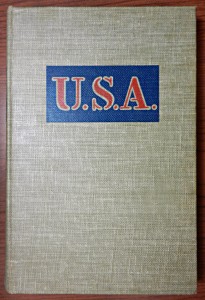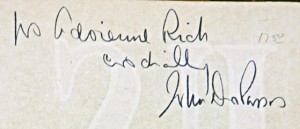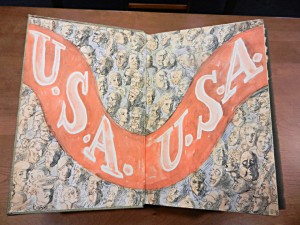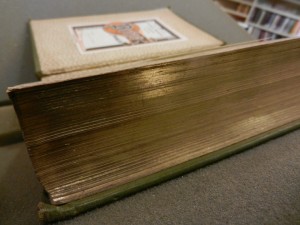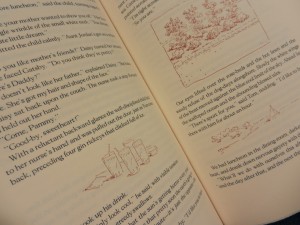
In addition to the over 7,000 linear feet of archival collections made available for study at the University of Houston Special Collections, we are also proud to offer over 100,000 rare and antique books for use in our reading room. Each month we will highlight a text from our collections and what makes it so special. This month, Matt Richardson shares John Dos Passos’ Nineteen Nineteen from the U.S.A. trilogy.
John Dos Passos’ U.S.A. is a sprawling look at American life in the early 20th century that takes place across 3 novels, several decades, and over 1000 pages. Consisting of the novels The 42nd Parallel (1930), Nineteen Nineteen (1932), and The Big Money (1936), it was first published as single volume in 1938 by Harcourt Brace. In addition to the rather straightforward narrative passages, Dos Passos’ work incorporates collections of headlines and popular songs in “Newsreel” segments, impressionistic renderings called the “Camera Eye,” and short biographies, often satiric, of prominent Americans. Beyond the complexity and innovation of the form itself, the element that typically garners the most critical attention is the cinematic stream of consciousness Camera Eye, which often elicits comparisons to Joyce. Though the novels purport to be the epic of one nation, Dos Passos’ U.S.A. inevitably overflows those boundaries, as it is filled with characters who frequently journey abroad and are continually shaped by their imaginings of and interactions with the wider world. This perspective is especially apparent in the middle novel of the trilogy, Nineteen Nineteen, which focuses on the trying years of World War I and the unsettled peace that followed it.
UH Libraries’ Special Collections has the distinct pleasure of holding a 1946 printing of Nineteen Nineteen signed by Dos Passos himself. Interestingly, the inscription reads: “To Adrienne Rich cordially John Dos Passos”. How the author might have encountered the American poet, essayist, and feminist, or for that matter how the University of Houston Libraries Special Collections later came into possession of her copy, would no doubt make for an interesting tale in its own right. (Though it’s not her only appearance in our collections). And since this 1946 printing was originally issued as a box set by Houghton Mifflin, one wonders what became of its companion copies of The 42nd Parallel and The Big Money. Bound in rather austere tan buckram with a stencil-style “U.S.A.” stamped across a small blue field, the exterior of the book almost evokes a government provision of the type Dos Passos’ enlisted men might receive. In contrast, the interior includes vivid end-sheets and illustrations by Reginald Marsh.
And should the 1000+ page epic constitute more time than you can devote to our reading room, fear not! After you’ve taken a look at our signed copy here in Special Collections, you’ll be pleased to find circulating copies of the U.S.A. trilogy in the general collections stacks of the M.D. Anderson Library.
In addition to the over 7,000 linear feet of archival collections made available for study at the University of Houston Special Collections, we are also proud to offer over 100,000 rare and antique books for use in our reading room. Each month we will highlight a text from our collections and what makes it so special.
This week, as we observe Banned Books Week along with the American Library Association and other members of the book community, we shift our formula a bit and focus on works in our collection which have historically been challenged, banned, or otherwise removed from public consumption. The chance overlap of National Hispanic Heritage Month makes for a unique opportunity to highlight our Kanellos Latino Literary Movement Collection.
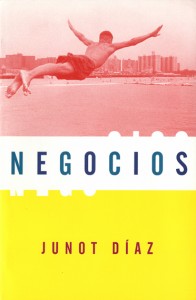
cover of Negocios by Junot Díaz (1997)
Banned “Confiscated” Books of the Month Moment: Unfortunately, there are a few. Negocios by Junot Díaz (his Spanish translation of the English language Drown), Zoot Suit and Other Plays by Luis Valdez, and The Magic of Blood by Dagoberto Gilb were all challenged by the Tucson Unified School District in 2012 and, also, all part of a generous donation of works from Dr. Nicolás Kanellos (founder and director of Arte Público Press and the driving force behind the Recovering the U.S. Hispanic Literary Heritage project). Thanks to his work, foresight, and longstanding connections in the community, the Kanellos Latino Literary Movement Collection, consisting of over 1,000 books, covering a broad scope and time range of works printed in limited runs, unpublished works, and other writings critical to scholars studying Latino literature, is available for study at the University of Houston Special Collections.
Why so Special Scary? Warning! According to the Tucson Unified School District’s decision in the wake of the passage of Arizona House Bill 2281, these books may “promote the overthrow of the United States Government… promote resentment toward a race or class of people,” or “advocate ethnic solidarity instead of the treatment of pupils as individuals.”
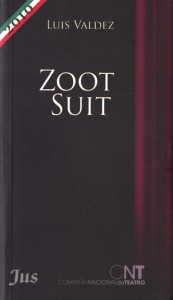
cover of Zoot Suit by Luis Valdez (2010)
In 2012, rather than fight 2281, Tucson USD officials chose a path of compliance that suspended the district’s Mexican American Studies program. This process included a public show of collecting, boxing, and carrying off a number of books that were part of the Mexican American Studies teaching materials, sometimes in the presence of students. District officials insisted that they were not “banning” books, simply “confiscating” a handful of the more egregious outliers. And, in the spirit of Banned Books Week, who are we to quibble? A closer look at the MAS reading list, however, will raise some eyebrows. In addition to the aforementioned “dangerous” works, other pieces on the reading list include revered Latina authors like Sandra Cisneros, as well as canonical and mainstream “Western” or Eurocentric works, like Shakespeare’s “The Tempest” and Henry David Thoreau’s “Civil Disobedience.”
In 2013, a federal court order mandated reinstatement of the program as part of federal desegregation laws aimed at providing equal eduation. While the issue remains a contentious one in Arizona politics, it is hoped and assumed that this school year, Shakespeare, Thoreau, and all the rest have found a home in the Tucson USD curriculum.
Location: Those interested (and brave enough) to study these works can access them in the Special Collections Reading Room during our normal hours. With Banned Books Week and National Hispanic Heritage Month in full swing, why wouldn’t you visit us?
In addition to the over 7,000 linear feet of archival collections made available for study at the University of Houston Special Collections, we are also proud to offer over 100,000 rare and antique books for use in our reading room. Each month we will highlight a text from our collections and what makes it so special.
This week, as we observe Banned Books Week along with the American Library Association and other members of the book community, we shift our formula a bit and focus on works in our collection which have historically been challenged, banned, or otherwise removed from public consumption.
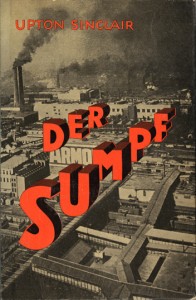
cover of Der Sumpf (or The Jungle) by Upton Sinclair (1926)
BANNED Book of the Month Moment: Der Sumpf (or The Jungle) by Upton Sinclair.
Why So Special Scary? Sinclair’s 1906 muckraking masterwork, depicting the bleak struggle of immigrants in the indifferent meat-grinder of U.S. industrialization, left us more with queasy stomachs than ready to pick up the hue and cry of the downtrodden masses. Having dedicated the work to “The Workingmen of America,” the irony of the book’s lasting impact was not lost on Sinclair who famously quipped, “I aimed for the public’s heart, and by accident I hit it in the stomach.” Sinclair’s political affiliations made the book an easy target for the pseudo-censorship of those fearing the insidious nature of his ideas. (President Theodore Roosevelt, who reportedly called Sinclair a “crackpot,” wrote to the author to advise that after reading a “good deal” of The Jungle he did “not think very much of [Sinclair’s] ecclesiastical correspondent,” that he had come to “distrust men of hysterical temperament,” but “this has nothing to do with the fact that the specific evils… shall, if their existence be proved… be eradicated.”)
Originally published as a serial in Appeal to Reason, major publishers politely passed on the work leaving Sinclair to pay for the first printing himself (see our copy published by “The Jungle Publishing Co., New York” and inscribed “To Rev. Washington Gladden with the compliments of the Author”), before Doubleday, Page & Co. agreed to publish a shorter version in 1906. In light of this particular week, though, our German translation caught my eye not for reasons of tacit disapproval from on high, but a more macabre spectacle that it would involve.
First translated into German in the early 1920s, Der Sumpf may raise some eyebrows from those more well-versed in Deutsch. Literally translated into English as, The Swamp, the peculiarity of the title speaks to the challenges of accurately translating literature across cultures, but perhaps more pointedly calls to mind the muck and mire in which the struggling laborers like Jurgis, young Ona, and their family find themselves. A rose by any other name, however, was certain to burn in the mania of German Nationalsozialismus. Judged contrary to the ideals of Nazism, the works of Ernest Hemingway, Jack London, Jon Dos Passos, and countless others burned on the pyres lit by students and educators in the early 1930s alongside Der Sumpf.
But, the Nazis’ cleansing fires did not burn them all, and we have a copy to prove it.
Location: Our 1926 German edition of Der Sumpf can be viewed and studied in the Special Collections Reading Room during normal research hours. We invite interested parties to visit us and request call number PS3537.I85 J8515 1926 as we look forward to assisting you in your research during Banned Books Week.
In addition to the over 7,000 linear feet of archival collections made available for study at the University of Houston Special Collections, we are also proud to offer over 100,000 rare and antique books for use in our reading room. Each month we will highlight a text from our collections and what makes it so special.
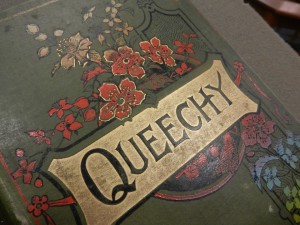
cover of Queechy / by Elizabeth Wetherell (Susan Warner)
Book of the Month: Queechy by Elizabeth Wetherell, as recommended by Julie Grob, Coordinator for Instruction at the University of Houston Special Collections.
Why So Special? “The pictorial cloth binding with a decoration of flowers that are multicolored,” writes Grob. “I’m a sucker for over-the-top publishers bindings from the 19th century, and this is one of the more elaborate in our collection.”
Originally published in 1852, Queechy was Susan Warner’s second novel, following her widely-translated debut, The Wide, Wide World (1850), also written under the pen name Elizabeth Wetherell. That book’s popularity gave Warner the distinction of being one of the most popular authors of a new nation still finding its literary voice. Our copy of Queechy is a glittering and gilded display that no doubt would have brought color to the cheeks of Warner’s Puritan forebearers. “Pictorial green cloth stamped in gold, red, blue, yellow and black. Edges gilt.”
Location: Pictures will not do this one justice. If you would care for a closer look, Queechy is available for study in the University of Houston Special Collections Reading Room, during our normal research hours. To spend some time with Fleda Ringgan as she crisscrosses the Atlantic, please request PS3155.Q4 1800z.
In addition to the over 7,000 linear feet of archival collections made available for study at the University of Houston Special Collections, we are also proud to offer over 100,000 rare and antique books for use in our reading room. Each month we will highlight a text from our collections.
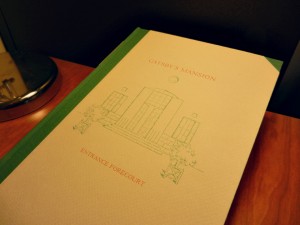
The Great Gatsby by F. Scott Fitzgerald, featuring artwork by Michael Graves
Book of the Month: The Great Gatsby by Francis Scott Fitzgerald; illustrated by Michael Graves (San Francisco : Arion Press, 1984)
Why So Special?: Required reading for just about every high school student as they come of age, Francis Scott Fitzgerald’s magnum opus is as American as Francis Scott Key’s offering. Routinely re-imagined every few decades on our collective silver screens to reflect our contemporary hopes and fears, Gatsby is often hailed as the novel on the subject of the American Dream, as amorphous an idea as that remains, full of all of our longing, anguish, confusion, desire, and “romantic readiness.” From Francis Cugat’s cover (commissioned and completed in the impatient haste of Scribners, seven months before the novel would even be ready–those eyes floating in the night, hinting at the enveloping darkness amid the carnival and light), to the sheer audacity and imagination of one James Gatz (convinced he cannot only reinvent himself of his own design, but he can will time to his bidding should he simply desire it enough), and on through the final words of the narrative, crystallizing our longing for and obsession with the illusory and the intangible (“So we beat on, boats against the current…”), The Great Gatsby has remained uniquely American.
Sometimes deceptively so.
For some it remains a pseudo-documentary of what Fitzgerald christened as “The Jazz Age,” The Roaring Twenties, “the most expensive orgy in history,” an American decade that found no proper suitor throughout her flirtations, and decided to stay on for the remainder of the century. To others it is a love story that sees desire run amok as it flies too close to a blazing white sun. Still others would present it as a cornerstone for the so-called “New York City novel,” an homage and tragic love story for Our New Paris; a story of The City that does not simply resign itself to the towering icons and alleyways of Manhattan, but also peers back behind the kitchen curtain windows of Long Island, revealing a complex web work of symbiotic and predatory class relations.
But Nick Carraway, our faithful and reliable narrator, would insist it has nothing to do with the New World’s metropolitan jewel, after all. He reflects on his “middle-west,” against the backdrop of that fateful summer of 1922:
That’s my middle-west–not the wheat or the prairies or the lost Swede towns but the thrilling, returning trains of my youth and the street lamps and sleigh bells in the frosty dark and the shadows of holly wreaths thrown by lighted windows on the snow. . . I see now that this has been a story of the West, after all–Tom and Gatsby, Daisy and Jordan and I, were all Westerners, and perhaps we possessed some deficiency in common which made us subtly unadaptable to Eastern life.
If the story of the American Dream is not rooted in the narrative of the so-called New World in the last handful of centuries leading up to that frenetic decade, full of all their blood and loss, then from where else does it originate? As if to underscore the point, it finally occurs to Nick while flailing about for his lost Eden at the tale’s conclusion, preparing to flee the corruption of the east, bound for his old, familiar home, he sprawls out on the Long Island beach and broods “on the old unknown world”:
And as the moon rose higher the inessential houses began to melt away until gradually I became aware of the old island here that flowered once for Dutch sailors’ eyes–a fresh, green breast of the new world. Its vanished trees, the trees that had made way for Gatsby’s house, had once pandered in whispers to the last and greatest of all human dreams; for a transitory enchanted moment man must have held his breath in the presence of this continent, compelled into an aesthetic contemplation he neither understood nor desired, face to face for the last time in history with something commensurate to his capacity for wonder.
And so it has remained for all of us, as we come of age in the New World, chasing the siren songs of phantasmal green lights hovering on our horizons.
This Arion Press imprint is limited to 400 copies and features the artwork of Michael Graves, of the New York Five fame, on the binding and throughout Fitzgerald’s prose. The text hops and springs over and around the illustrations of Graves, not unlike that running Buchanan lawn, “jumping over sun-dials and brick walks and burning gardens.” This particular volume also includes the signature of Graves below the colophon. Types used are Goudy Light and Piehler Capitals and the paper is French mould-made Rives, with a deckle edge.
Location: Available for study in the University of Houston Special Collections Reading Room (sorry, no beach reading with this one), Monday through Friday 9am-5pm. Bibliophiles or the simply curious should request call number PS3511.I9 G7 1984.
